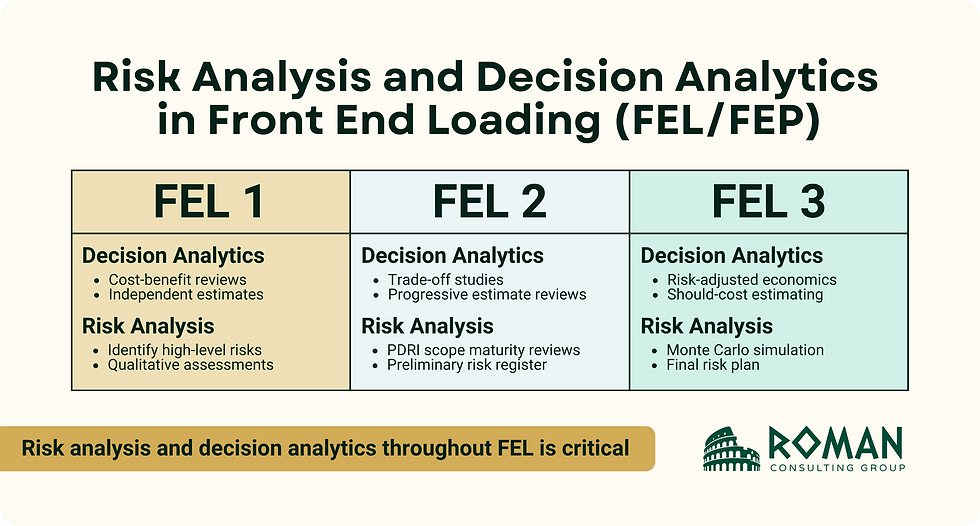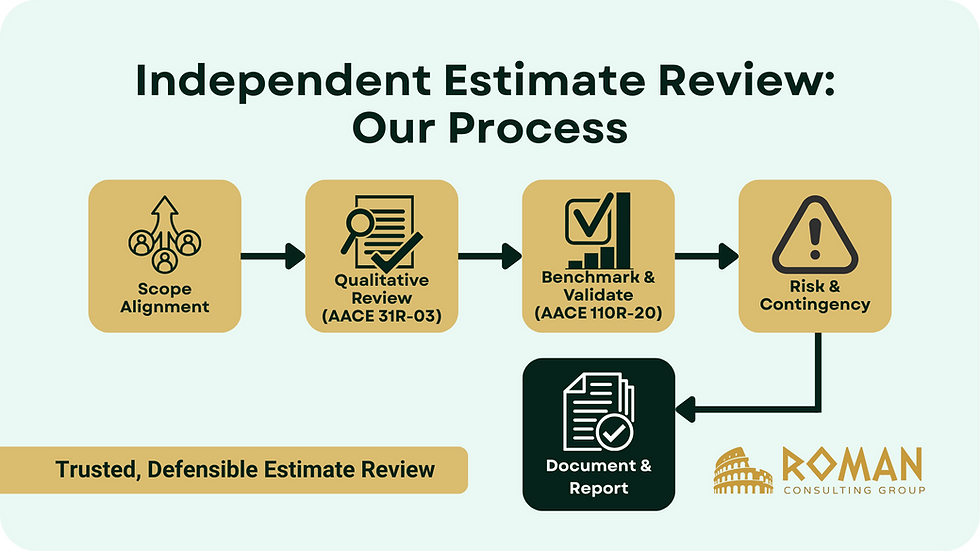Is Your Basis of Estimate Setting Your Project Up for Success?
- Roger Farish

- Sep 8
- 5 min read
Why the BoE matters
A strong Basis of Estimate is the audit trail for your number. It clarifies scope and boundaries, shows how the estimate was built, records the data sources and dates behind it, and makes uncertainty visible so leaders can judge credibility. Build the BoE in parallel with the estimate and write it so a reviewer who did not build the estimate can follow the logic. If you want a concise primer on estimating fundamentals, see What Is Capital Project Estimating.

What decision makers actually need from a BoE
Replicable logic: another estimator can follow your steps and recreate the number.
Traceability: major assumptions and inputs are easy to find and linked to the WBS.
Currency: prices, labor bases, and indices are time stamped so updates are disciplined.
Separation of uncertainty: containments (mitigations), contingency, and management reserve are distinct.
Reconciliation: it is clear how and why the number changed since the last gate.
Five habits that lift BoE quality from complete to decision ready
Document assumptions clearly
Include the assumptions necessary for a knowledgeable reader to understand and, if needed, recreate the estimate. Where helpful, point to the WBS element the assumption influences or add a simple impact tag like up, down, or neutral. Dollarizing is not required in the BoE.
Time stamp the basis and plan escalation
For each major commodity and labor basis, include the base date, any quote validity window, and the escalation index family you intend to use. Keep a short quote log in the BoE and put the detailed log in the backup. This prevents quiet pricing drift and makes roll forwards consistent.
Show how the number moved
Use a simple waterfall from the prior estimate that isolates changes from scope, quantity maturity, market or price updates, productivity, and method changes. Place detailed trending in the attachments. A clear waterfall also speeds Independent Estimate Reviews.
Separate uncertainty tools cleanly
Mitigations: actions included in the estimate to reduce risk, inside the base.
Contingency: allowance for inherent variability within defined scope, inside the estimate, with the method stated.
Management reserve: funds for potential scope change, outside the estimate.
Labeling these avoids double counting and stops scope gaps from hiding inside contingency.
Design for an independent read
Use the same code of accounts the estimate uses, define units and currency, and write plainly. If a reviewer cannot follow the BoE without tribal knowledge, approvals will stall.
FEL focused guidance owners find useful
FEL 1 (Class 5): assumptions carry the number
Keep it concise but explicit on boundaries, status of definition, and methods by area such as parametric and factored approaches. Using PDRI can help structure definition.
Document the assumptions necessary for transparency and replication, and tie them to allowances or WBS elements where useful.
Record a pricing base date and the intended escalation approach to avoid false precision later.
For how early risk framing feeds the BoE, see When to Start Risk Analysis in Front End Loading.
FEL 2 (Class 4): quantities and method take the lead
Shift from factors to traceable quantities and a dated quote log. Explain how missing MTOs are bridged and when they will be replaced.
Add a short benchmark table such as unit costs or TIC per major block with quick variance notes. For a companion method that supports commercial leverage, see Should-Cost Estimating.
Keep a visible change log so approvers see what shifted since FEL 1 and why.
Basis of Estimate checklist
Purpose, decision context, and estimate class
Scope boundaries and what is out, aligned to the WBS
Methods, tools, codes, and data sources by area or discipline
Assumptions are documented clearly and easy to find
Quantity pedigree, with gaps and allowances listed
Pricing sources with dates, escalation basis, and a quote log noted
Risks, mitigations, contingency method and confidence, and management reserve are defined and separate
Reconciliation waterfall to the prior estimate, with deeper trending attached
Attachments such as the full quote log, key references, risk notes, escalation calculations, and benchmarking
Common BoE pitfalls with fast fixes
Implied scope such as owner’s costs, utilities tie ins, or land is not called out. Fix: add an “items a reviewer might expect” list under Exclusions.
Expired quotes with no refresh plan. Fix: add base dates and validity windows and state how you will roll forward.
Contingency hiding scope. Fix: move unfunded scope to assumptions or allowances and keep contingency for variability, not omissions.
No reconciliation to the prior baseline. Fix: add the one page waterfall and link to trending. For broader estimating pitfalls, see Top 5 Estimating Mistakes in Capital Projects.
How we approach this at ROMAN
At ROMAN Consulting Group, our work is independent and front end by design. Our aim is simple: reduce project cost uncertainty so leaders can make stronger investment decisions. We provide independent estimating support and independent estimate reviews early, when a clear record of scope, methods, assumptions, and market basis can still shape choices. Our reviews are objective and practical, bringing structure and rigor to the front end of projects so owners move faster with fewer surprises.
FAQ
What is a Basis of Estimate in capital projects?
A Basis of Estimate is the documented foundation of a cost estimate that explains scope, methods, data and dates, key assumptions, risk and mitigations, and reconciliation to prior estimates.
What should a BoE include at FEL 1 and FEL 2 Class 4?
At FEL 1 (Class 5), focus on boundaries, status of definition, and clear assumptions. At FEL 2 (Class 4), shift to traceable quantities, a dated quote log, benchmarking, and a visible change log.
Do I need to quantify every assumption in the BoE?
No. Document assumptions clearly so a knowledgeable reader can understand and, if needed, recreate the estimate. Point to the WBS or add simple impact tags where helpful.
How do mitigations, contingency, and management reserve differ?
Mitigations are actions included in the base estimate to reduce risk. Contingency covers inherent variability within defined scope. Management reserve sits outside the estimate for potential scope change.
How often should a BoE be updated?
Update the BoE at each gate and whenever decisions change scope, quantities, pricing bases, or execution. Use a short reconciliation waterfall to show what moved and why.





Comments